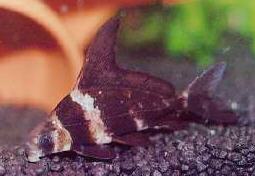"Myxocyprinus asiaticus is one of the two surviving
cotostomids (suckers) found in Asia, the other being the Siberian Cotostomus
rotratus, and originates from mountain streams in the Yangtze River, China.
Consequently Myxocyprinus asiaticus enjoy plenty of aeration and can
tolerate wide temperature variations (65 - 82°F). I am told they may even
be kept outdoors in summer although prolonged low temperatures should be
avoided. My fish seem comfortable at around 78°F.
Water quality is not critical but, as with many fish, Myxocyprinus
asiaticus are sensitive to any abrupt changes and are particularly
susceptible to nitrates. Good, powerful filtration and regular partial
water changes are essential. Don't become overly concerned if the
fish frequently changes colour. Batfish will lighten and darken as
their mood takes them.
Myxocyprinus asiaticus are an ideal community fish.
They can be kept as individuals but are at their most impressive in a shoal.
Additionally they are placid in nature and continually on the move in the
search for food stopping to rest only occasionally. The fish generally remain
on the substrate swimming in an almost a clownish manner, along the edges and
contours of the aquarium. They will on occasion, swim along long-leafed plants
or up the sides of the tank until they are inverted and drift back down to the
bottom. Interestingly, their active nature ceases at night. Almost immediately
after lights out Myxocyprinus asiaticus will stop in situ and rest.
The fish are easily startled when first introduced to a new
aquarium so take care when approaching the tank. Aside from this the only draw
back to this fascinating fish is its potential adult size. In nature
Myxocyprinus asiaticus can reach an amazing three feet in length! As can
be seen in the photograph the fish has a high body profile in relation to its
length and the tip of the dorsal fin can reach to over two feet in height.
Fortunately, Batfish are slow growing. In my experience they grow around 2
inches per year and it is thought that the fish can survive over 25 years. The
fish also loose their white "stripes" with age. The adult fish take on an
overall darker appearance although this is somewhat dependent on their diet.
Feeding brine shrimp brings out pink rather than orange flecks in the fish's
colouration.
Batfish enjoy a variety of foods and can be fed flake and
vegetable matter, although this must be supplemented with either live or frozen
foods such as bloodworm and the aforementioned brine shrimp. Always observe the
fish when feeding as they can stop eating. If this happens check the aquarium
for nitrate, perform a water change if necessary and begin feeding live food
only.
Almost nothing is known about the breeding of Myxocyprinus
asiaticus. In fact the distinct lack of success by experts in this area was
once attributed to the rumour that only males were exported in an attempt by
the Chinese to corner the Myxo market! Personally I doubt this on the basis
that it is very difficult to sex young Batfish (see data table below) and the
hence it is unlikely that the Chinese would have been able to control the
export.
It is however thought that breeding is similar to that of
Cotostomus cotostomus, the American counterpart to the Myxo's Siberian
relation, Cotostomus rotratus. Cotostomus sp. spawn in groups
after a migration to quieter waters in the summer and depending on the size and
species, some American cotostomids lay upto 50,000 eggs which, are guarded by
the male."

